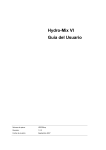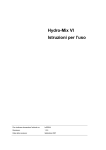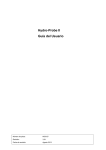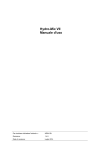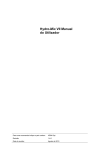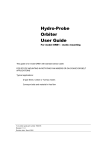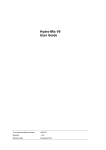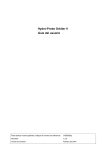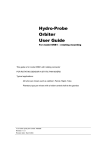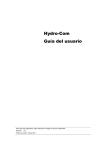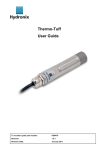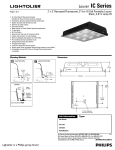Download Hydro-Mix VI User Guide
Transcript
Hydro-Mix VI User Guide To re-order quote part number: HD0304 Revision: 1.2.0 Revision date: September 2007 Copyright Neither the whole or any part of the information contained in nor the product described in this documentation may be adapted or reproduced in any material form except with the prior written approval of Hydronix Limited, hereinafter referred to as Hydronix. © 2006 Hydronix Limited 7 Riverside Business Centre Walnut Tree Close Guildford Surrey GU1 4UG United Kingdom All rights reserved CUSTOMER RESPONSIBILITY The customer in applying the product described in this documentation accepts that the product is a programmable electronic system which is inherently complex and which may not be completely free of errors. In doing so the customer therefore undertakes responsibility to ensure that the product is properly installed commissioned operated and maintained by competent and suitably trained persons and in accordance with any instructions or safety precautions made available or good engineering practice and to thoroughly verify the use of the product in the particular application. ERRORS IN DOCUMENTATION The product described in this documentation is subject to continuous development and improvement. All information of a technical nature and particulars of the product and its use including the information and particulars contained in this documentation are given by Hydronix in good faith. Hydronix welcomes comments and suggestions relating to the product and this documentation ACKNOWLEDGEMENTS Hydronix, Hydro-Probe, Hydro-Mix, Hydro-View and Hydro-Control are Registered Trade Marks of Hydronix Limited HYDRO-MIX VI USER GUIDE 2 HD0304 REV. 1.2.0 Revision history Revision No. Date Description of change 1.0.0 January 2006 Original version 1.1.0 May 2006 Addition of Appendix A – Default sensor parameters 1.2.0 September 2007 Addition of Appendix B – Replacement Ceramic Instructions HYDRO-MIX VI USER GUIDE HD0304 REV 1.2.0 3 HYDRO-MIX VI USER GUIDE 4 HD0304 REV. 1.2.0 Table of Contents Chapter 1 Introduction ...................................................................................................................... 9 Introduction ....................................................................................................................................... 9 Measuring techniques ......................................................................................................................10 Sensor connection and configuration...............................................................................................10 Chapter 2 Mechanical Installation....................................................................................................11 General to all applications................................................................................................................11 Positioning the sensor......................................................................................................................12 Installing the sensor .........................................................................................................................16 Replacing the ceramic .....................................................................................................................19 Chapter 3 Electrical Installation and Communication.......................................................................21 Installation guidelines.......................................................................................................................21 Analogue output...............................................................................................................................21 RS485 multi-drop connection...........................................................................................................23 Hydro-Control IV/ Hydro-View connection........................................................................................23 Connecting to a PC..........................................................................................................................24 Chapter 4 Configuration...................................................................................................................27 Configuring the sensor .....................................................................................................................27 Chapter 5 Optimising sensor performance ......................................................................................33 Chapter 6 Frequently asked questions ............................................................................................35 Chapter 7 Sensor diagnostics..........................................................................................................39 Chapter 8 Technical specification ....................................................................................................41 Appendix A Default parameters..........................................................................................................43 Appendix B Ceramic Disc Replacement.............................................................................................45 HYDRO-MIX VI USER GUIDE HD0304 REV 1.2.0 5 Table of Figures Figure 1 - The Hydro-Mix VI and clamp ring..........................................................................................7 Figure 2 - Connecting the sensor (overview).......................................................................................10 Figure 3 - Mounting in flat surface .......................................................................................................12 Figure 4 - Mounting in curved surface .................................................................................................12 Figure 5 - Position of sensor in a turbo mixer ......................................................................................13 Figure 6 - Position of sensor in side wall of mixer ...............................................................................13 Figure 7 - Position of sensor in a planetary mixer ...............................................................................14 Figure 8 - Position of sensor in a horizontal shaft or ribbon mixer.......................................................14 Figure 9 - Position of sensor in a twin shaft horizontal mixer ..............................................................15 Figure 10 - Sensor installation.............................................................................................................16 Figure 11 - Clamp ring components ....................................................................................................17 Figure 12 Fixing plate prepared for attaching clamp ring ...................................................................17 Figure 13 - Clamp ring assembled and fitted to fixing plate.................................................................18 Figure 14 - Clamp ring (0033) fitted to fixing plate (0021) and Hydro-Mix VI.......................................18 Figure 15 - Sensor cable connections .................................................................................................22 Figure 16 - RS485 multi-drop connection............................................................................................23 Figure 17 - Connecting to a Hydro-Control IV or Hydro-View..............................................................23 Figure 18 - RS232/485 converter connections (1)...............................................................................25 Figure 19 - RS232/485 converter connections (2)...............................................................................25 Figure 20 - RS232/485 converter connections (3)...............................................................................25 Figure 21 - Internal/external excitation of the digital input ...................................................................29 Figure 22 - Typical moisture curve ......................................................................................................30 Figure 23 - Graph showing raw signal during mix cycle ......................................................................30 Figure 24 - Filtering the RAW signal (1) ..............................................................................................31 Figure 25 - Filtering the RAW signal (2) ..............................................................................................31 HYDRO-MIX VI USER GUIDE 6 HD0304 REV. 1.2.0 Removable Wear Ring holds ceramic disc 108mm (4.25 inch) Ceramic disc 4 fixing screws 125mm (5.1 inch) Hydro-Mix VI body houses sensitive electronics Clamp Ring PACKED CONTENTS: Mil-Spec Electrical connector HM06T Hydro-Mix VI sensor 0033 Adjustable clamp ring Minimum accessories (if ordered) 0090A Sensor cable (4m) 0021 Fixing plate Figure 1 - The Hydro-Mix VI and clamp ring Available accessories: 0021 Fixing plate for welding to mixer 0033 Adjustable clamp ring (supplied with sensor). (Additional rings can be ordered if required) 0035 Blanking plate for blanking hole in the mixer when sensor is removed 0090A 4m sensor cable 0090A-10m 10m sensor cable 0090A-25m 25m sensor cable 0116 Power supply – 30 Watt for up to 4 sensors 0049A RS232/485 converter (DIN rail mounting) 0049B RS232/485 converter (9 pin D type to terminal block) SIM01A USB Sensor Interface Module including cables and power supply 0815 Replacement ceramic kit (ceramic and protection ring kit) 0830 Replacement ceramic kit (excluding protection ring) 0840 Replacement wear ring (including screws) Hydro-Com configuration and diagnostics software is available for free download from www.hydronix.com HYDRO-MIX VI USER GUIDE HD0304 REV 1.2.0 7 HYDRO-MIX VI USER GUIDE 8 HD0304 REV. 1.2.0 Chapter 1 Introduction Introduction The Hydro-Mix VI digital microwave moisture sensor with integral signal processing provides a linear output (both analogue and digital). The sensor may be easily connected to any control system and is ideally suited to measure the moisture of materials in mixer applications as well as other process control environments. The sensor reads at 25 times per second, this enables rapid detection of changes in moisture content in the process, including determination of homogeneity. The sensor may be configured remotely when connected to a PC using dedicated Hydronix software. A large number of parameters are selectable, such as the type of output and the filtering characteristics. The sensor is constructed to operate under the most arduous conditions with a wear life of many years. The Hydro-Mix VI should never be subjected to unnecessary impact damage as it houses sensitive electronics. In particular, the ceramic faceplate, although extremely hardwearing, is brittle and may crack if subjected to severe impact. CAUTION – NEVER HIT THE CERAMIC Care should also be taken to ensure that the Hydro-Mix VI has been correctly installed and in such a manner to ensure representative sampling of the material concerned. Suitable applications The Hydro-Mix VI microwave moisture measuring sensor may be successfully used in the following applications: • • Static pan mixers • Planetary mixers • Turbo mixers • Single and twin shaft horizontal mixers • Ribbon mixers Flush mounted in chutes or similar applications NOTE: For rotating pan mixers such as the Eirich and Croker liner mixers, a static mounted Hydro-Probe Orbiter is recommended. HYDRO-MIX VI USER GUIDE HD0304 REV 1.2.0 9 CHAPTER 1 INTRODUCTION Measuring techniques The Hydro-Mix VI uses the unique Hydronix digital microwave technique that provides a more sensitive measurement compared with analogue techniques. Sensor connection and configuration As with other Hydronix digital microwave sensors, the Hydro-Mix VI may be remotely configured using a digital serial connection and a PC running Hydro-Com diagnostics software. For communication with a PC Hydronix supply RS232-485 converters and a USB Sensor Interface Module (See page 26). There are three basic configurations by which the Hydro-Mix VI can be connected to the mixer control system: • Analogue output – A DC output is configurable to: • 4-20 mA • 0-20 mA • 0-10 V output can be achieved using the 500 Ohm resistor supplied with the sensor cable. • Digital control – an RS485 serial interface permits direct exchange of data and control information between the sensor and the plant control computer or Hydro-Control system. • Compatibility mode - this allows a Hydro-Mix VI to connect to a Hydro-Control IV or Hydro-View unit. The sensor may be configured to output a linear value of between 0-100 unscaled units with the recipe calibration being performed in the control system. Alternatively it is also possible to internally calibrate the sensor to output a real moisture value. Power supply +15V - 30 Vdc, 1A min. Analogue output 0-20mA, 4-20mA, 0-10V Digital inputs RS485 serial communications Figure 2 - Connecting the sensor (overview) HYDRO-MIX VI USER GUIDE 10 HD0304 REV. 1.2.0 Chapter 2 Mechanical Installation A significant benefit of the Hydronix system is that only one sensor is required in the mixer. However, it is important that it is positioned correctly in relation to the mixer floor, aggregate and water inlets, and other moving parts such as blades and paddles. General to all applications Always ensure that the sensor is correctly positioned in relation to the mixer floor and other moving parts such as paddles. Although paddles or scraper blades can be a useful mechanism to keep the sensor free from material build up, they could cause damage to an incorrectly positioned sensor. It will be necessary to periodically check the position as the mixer blades, paddles and floor wear. The sensor will occasionally need to be adjusted out from the mixer to maintain the correct position. In addition, the blades will need to be lowered to maintain efficiency of the mixing action and cleanliness of the sensor faceplate. For accurate and representative moisture measurement the sensor must be in contact with the moving stream of material. It is equally important that no material can build up over the sensor face to obscure the sensor readings. If the sensor is allowed to protrude into the mixer it will be susceptible to damage from the mixer blades/paddles as well as from aggregates becoming trapped between the paddles, mixer floor and exposed side wall of the sensor. Damaged caused under these circumstances will not be covered by warranty Follow the advice below for good sensor positioning: • It is a good idea to provide a small inspection lid in the mixer cover, so that during mixing, and when the mixer is empty, the sensor face may be observed without having to raise the main cover plate. • If the floor is not level fit the sensor in the highest point in the floor. • Ensure that the sensor is fitted away from the water, cement and aggregate entry points. • If the mixer surface is curved, for example in a side wall or horizontal shaft mixer, ensure that the sensor does not protrude to hit the blades and that it is flush to the inside radius of the mixer. • Avoid areas of severe turbulence. The optimal signal will be obtained where there is a smooth flow of material over the sensor. • The sensor should be positioned where it will see a continuous sample of the flowing material and where the sweeping action of the blades ensures no build up of material on the face of the sensor. • Position the sensor away from any electrical interference (See Chapter 3). • Position the sensor so that it may be easily accessible for routine maintenance, adjustment and cleaning. HYDRO-MIX VI USER GUIDE HD0304 REV 1.2.0 11 CHAPTER 2 MECHANICAL INSTALLATION Positioning the sensor The sensor may be installed into many types of mixer or application. In most cases the sensor will work exceptionally well with the standard filtering parameters. Some mixer types and certain applications may require further adjustments to the internal filtering parameters of the sensor. For further information, please contact your dealer or e-mail Hydronix at [email protected]. General mounting advice For installations in flat surfaces, the top of the sensor must be flush with the floor of the mixer. ; : Figure 3 - Mounting in flat surface When installing the sensor in curved surfaces, ensure that the centre of the ceramic is flush with the radius of the mixer wall. Figure 4 - Mounting in curved surface In all installations, it is recommended that the sensor is fitted in an area where it is away from any possible collection of ‘sitting’ water. HYDRO-MIX VI USER GUIDE 12 HD0304 REV. 1.2.0 MECHANICAL INSTALLATION CHAPTER 2 Turbo mixers The sensor may be positioned in the floor or side wall of static pan mixers. Generally, floor mounting is recommended as the mixer can be used with small batch sizes. If the side wall installation is used it must be ensured that there is sufficient material to cover the sensor. When the sensor is mounted in the floor, it should be approximately 2/3 distance from the mixer centre to the side wall. 2/3 radius Sidewall Mounted Floor Mounted Figure 5 - Position of sensor in a turbo mixer If the sensor is mounted in the side wall, it should be positioned approximately 60mm above the floor of the mixer. Approximately 60mm (2 ½ inches) Figure 6 - Position of sensor in side wall of mixer HYDRO-MIX VI USER GUIDE HD0304 REV 1.2.0 13 CHAPTER 2 MECHANICAL INSTALLATION Planetary mixer The sensor should be fitted in the base of the planetary mixer, ideally in a position where the flow of material is smoothest, away from the area of severe turbulence caused by the mixing action of the blades. This is normally close to the side wall of the mixer. Therefore it is generally recommended that the sensor be positioned with the inner edge approximately 10 cm to 15cm (4-6 inches) from the side wall of the mixer. The minimum distance should never be less than 5cm (2 inches). See the advice for flat surface mounting on page 12. Approximately 10cm (4ins) Minimum 5cm (2ins) Figure 7 - Position of sensor in a planetary mixer Single shaft horizontal and ribbon mixers The sensor is generally best positioned near the base of horizontal mixers 30 degrees above the base to prevent water pooling in the base covering the sensor face. It should be placed approximately half way along the length of the mixer. See guidance for mounting in curved surfaces on page 12. NOTE: The sensor must be on the ‘up’ stroke of the mixer 30° Figure 8 - Position of sensor in a horizontal shaft or ribbon mixer HYDRO-MIX VI USER GUIDE 14 HD0304 REV. 1.2.0 MECHANICAL INSTALLATION CHAPTER 2 Twin shaft horizontal mixers The best position on horizontal twin shaft mixers is half way along the length of the mixer, near the base at approximately 30 degrees above the base to prevent water pooling in the base covering the sensor face. The sensor should be mounted on the ‘up’ stroke of the mixer. If this is not possible, for example when the mixer unloading doors obstruct this area, then it should be positioned on the opposite side on the ‘down’ stroke. See guidance for installation in curved surfaces on page 12. Recommended ‘up’ stroke position Alternative ‘down’ stroke position Figure 9 - Position of sensor in a twin shaft horizontal mixer HYDRO-MIX VI USER GUIDE HD0304 REV 1.2.0 15 CHAPTER 2 MECHANICAL INSTALLATION Installing the sensor The Hydro-Mix VI is fitted to the mixer using a fixing plate (part no 0021) welded to the permanent floor or side wall of the mixer and the adjustable clamp ring assembly (part no 0033) which is supplied with the sensor. The adjustable clamp ring assembly facilitates the correct positioning and subsequent height adjustment of the sensor. 127mm (5 inch) hole for fixing plate Fill gap with sand or silicon sealant Mixer floor or wall Fixing plate (part no 0021) Clamp ring assembly (Part no: 0033) Hydro-Mix VI sensor Figure 10 - Sensor installation Cutting hole in mixer and fitting fixing plate A hole should be cut into the mixer before welding the fixing plate. The recommended minimum cut-out hole size is 127mm (5 inches). The actual size of the sensor is 108mm (4.25 inches). Having cut the hole in the mixer and checked the clearance for the sensor, the fixing plate should be welded to the mixer. HYDRO-MIX VI USER GUIDE 16 HD0304 REV. 1.2.0 MECHANICAL INSTALLATION CHAPTER 2 Fitting the clamp ring to the sensor The clamp ring comprises the following components: A. B. C. D. E. F. G. 3 x M8 screws 6 x M8 lock nuts (Three shown) 3 x M8 Nyloc nuts 3 x washers 2 x M6 screws 3 x M8 threaded stud Clamp ring F E C G A B D Figure 11 - Clamp ring components Threaded studs (F) Lock nuts (B) Fixing plate (part no. 0021) Figure 122 Fixing plate prepared for attaching clamp ring 1. Screw the 3 threaded studs (F) to the fixing plate (already welded to the mixer), and tighten securely using 3 lock nuts (B) 2. 3. Fit the clamp ring (G) onto the sensor using the 2 x M6 screws (E). Position the clamp ring so that adjustment is possible with the ceramic head level with the mixer floor or side wall. 4. Fit the clamp ring and sensor assembly over the threaded studs of the fixing plate and use the Nyloc nuts (C) and washers (D) to position the sensor with the ceramic level with the mixer floor or side wall HYDRO-MIX VI USER GUIDE HD0304 REV 1.2.0 17 CHAPTER 2 MECHANICAL INSTALLATION M8 screws (A) Clamp ring (G) M8 lock nuts (B) Washers (D) M8 Nyloc nuts (C) M6 screws (E) Figure 13 - Clamp ring assembled and fitted to fixing plate 5. Fit the three screws (A) along with the 3 remaining lock nuts (B) to the clamp ring to push against the fixing plate. 6. CHECK again to ensure that the sensor head is in the correct position, using a steel rule and ensure that the mixer blades and scrapers clear the ceramic face plate by manually rotating the blades. 7. Fully tighten the complete assembly including the lock nuts. 8. Once the sensor has been correctly fitted and adjusted, fill the gap around the sensor with silicone sealant (preferred) or compacted sand. Figure 14 - Clamp ring (0033) fitted to fixing plate (0021) and Hydro-Mix VI HYDRO-MIX VI USER GUIDE 18 HD0304 REV. 1.2.0 MECHANICAL INSTALLATION CHAPTER 2 Adjusting the sensor NEVER HIT THE CERAMIC THE CERAMIC IS VERY HARDWEARING BUT IS BRITTLE AND WILL CRACK IF STRUCK The ceramic face plate of the sensor is extremely resistant to abrasion. The mixer wear plates will wear more rapidly than the ceramic. Consequently from time to time it will be necessary to adjust the sensor so that it maintains the same relative position to the wear plates (following this procedure a recalibration of the recipes may be required). To move the sensor IN to the mixer • Clean out compacted sand or silicone sealant from around the sensor. • Loosen the lock nuts B and screws A. • Tighten nuts C evenly (max 50Nm or 37ft/lb) until the sensor is in the desired position. • Tighten screws A (20Nm or 15ft/lb). • Tighten lock nuts B (40Nm or 30 ft/lb). • Fill the gap around the mixer with silicone sealant (preferred) or compacted sand. To move the sensor OUT of the mixer • Clean out compacted sand or silicone sealant from around the sensor. • Loosen lock nuts B and nuts C. • Tighten screws A evenly (max 60Nm or 45ft/lb) until the sensor is in the desired position. • Tighten nuts C (20Nm or 15ft/lb). • Tighten lock nuts B (40Nm or 30ft/lb). • Fill the gap around the mixer with silicone sealant (preferred) or compacted sand. Removal of the sensor • Clean out compacted sand or silicone sealant from around the sensor. • Remove nuts C and carefully ease the sensor and clamp ring assembly from the mixer. Replacing the ceramic Should the ceramic face plate of the sensor become damaged it can easily be replaced by end users or their dealer. It is advised that a replacement kit (part no 0830) is held in reserve in case of this event. Full instructions on replacing the ceramic can be found in Appendix B or in the installation instructions accompanying the replacement kit. HYDRO-MIX VI USER GUIDE HD0304 REV 1.2.0 19 CHAPTER 2 MECHANICAL INSTALLATION Notes: HYDRO-MIX VI USER GUIDE 20 HD0304 REV. 1.2.0 Chapter 3 Electrical Installation and Communication The Hydro-Mix VI must be connected using the Hydronix sensor cable (part no 0090A), available in different lengths to suit the installation. Any extension cable required should be connected to the Hydronix sensor cable using a suitable screened junction box. See (Technical Specification, Chapter 8 for cable details). Installation guidelines • Ensure that the cable is of a suitable quality (see Chapter 8 ‘Technical Specification’). • Ensure that the RS485 cable is taken back into the control panel. This can be used for diagnostic purposes and takes the minimum of effort and cost to connect at the time of installation. • Route the signal cable away from any power cables, in particular the mixer power supply. • Check that the mixer is properly grounded. • Note that there is an M4 threaded hole provided on the bottom of the Hydro-Mix VI for a ground connection if required. • The sensor cable should only be grounded at the mixer. • Ensure that the cable screen is not connected at the control panel. • Ensure that there is continuity of the screen through any junction boxes. • Keep the number of cable joins to a minimum. Analogue output A DC current source generates an analogue signal proportional to one of a number of selectable parameters (e.g. filtered unscaled, filtered moisture, average moisture, etc). See Chapter 4 ‘Configuration’ or the Hydro-Com User Guide HD0273 for further details. Using the Hydro-Com or direct computer control, the output may be selected to be: • 4-20 mA • 0-20 mA - 0-10 V output can be achieved using the 500 Ohm resistor supplied with the sensor cable. HYDRO-MIX VI USER GUIDE HD0304 REV 1.2.0 21 CHAPTER 3 ELECTRICAL INSTALLATION/COMMUNICATION Twisted Pair Number MIL spec pins 1 1 2 2 3 3 4 4 5 5 6 6 A B C -D E F G J -D K H Sensor connections Cable colour +15-30V DC 0V 1st Digital input 1st Analogue Positive (+) 1st Analogue Return (-) RS485 A RS485 B 2nd Digital input 2nd Analogue Positive (+) 2nd Analogue Return (-) Screen Red Black Yellow Black (Cut back) Blue Black White Black Green Black (Cut back) Brown (where available) Black (where available) Screen A Red B Black C Yellow E Black D Blue F White G Black J Green K Black D Brown Table 1 - Sensor cable (Part no 0090A) connections 0090A twisted pair Sensor Cable H Junction box screen Do not connect screen at control cabinet. 500 Ohm resistor for 0-10V - 2nd Analogue Output (where available) RS485A + 2 Digital Input / Output RS485B nd Positive Return Positive Return + - st 1 Analogue Output st 1 Digital Input 0V +VE - + Supply (15-30V DC) Control Room Wiring Figure 15 - Sensor cable connections Note: The cable screen is grounded at the sensor. It is important to ensure that the plant where the sensor is installed is properly grounded. HYDRO-MIX VI USER GUIDE 22 HD0304 REV. 1.2.0 ELECTRICAL INSTALLATION/COMMUNICATION CHAPTER 3 RS485 multi-drop connection A Red C Yellow B Black E Black D Blue F White G Black J Green K Black D Brown The RS485 serial interface allows up to 16 sensors to be connected together via a multi-drop network. Each sensor should be connected using a waterproof junction box. 0090A twisted pair Sensor Cable H Junction box Screen Do not connect screen at control cabinet. A From other sensors B F G To PC or plant control device Figure 16 - RS485 multi-drop connection Hydro-Control IV/ Hydro-View connection A Red B Black C Yellow D Blue E Black F White G Black J Green K Black D Brown To connect to a Hydro-Control IV or Hydro-View, the Hydro-Mix VI needs to be set to compatibility mode. To operate in this mode the output type needs to be set to ‘Compatibility’ using Hydro-Com, see Chapter 4 ‘Configuration’. The 500 Ohm resistor supplied with the cable is required to convert the analogue current output to a voltage signal. This should be fitted as shown in Figure 19 at the Hydro-Control IV or Hydro-View. 0090A twisted pair Sensor Cable H Screen Junction box 500 Ohm resistor for 0 – 10 V 1 2 3 4 5 6 7 8 9 10 11 12 Hydro-Control IV (HC04) or Hydro-View (HV02) Connector Figure 17 - Connecting to a Hydro-Control IV or Hydro-View HYDRO-MIX VI USER GUIDE HD0304 REV 1.2.0 23 CHAPTER 3 ELECTRICAL INSTALLATION/COMMUNICATION Connecting to a PC A converter is required to connect one or more sensors to a PC when checking diagnostics and configuring the sensor. There are three types of converter supplied by Hydronix. RS232/485 converter – D type (Part no: 0049B) Manufactured by KK systems, this RS232/485 converter is suitable for connecting typically up to six sensors on a network. The converter has a terminal block for connecting the twisted pair RS485 A and B wires and can then be connected directly in to the PC serial communication port. RS232/485 converter – DIN rail mounting (Part no: 0049A) Manufactured by KK systems, this powered RS232/485 converter is suitable for connecting any number of sensors on a network. The converter has a terminal block for connecting the twisted pair RS485 A and B wires and can then be connected to a PC serial communication port. USB Sensor Interface Module (Part no: SIM01A) Manufactured by Hydronix, this USB-RS485 converter is suitable for connecting any number of sensors on a network. The converter has a terminal block for connecting the twisted pair RS485 A and B wires, and then connects to a USB port. The converter does not require external power, although a power supply is supplied and can be connected providing power to the sensor. See USB Sensor Interface Module User Guide (HD0303) for further information. RS485 line termination will not normally be required in applications with up to 100 m of cable. For longer lengths connect a resistor (approximately 100 Ohm) in a series with a 1000pF capacitor across each end of the cable. It is highly recommended that the RS485 signals be run to the control panel even if they are unlikely to be used as it will facilitate the use of diagnostic software should the need arise. HYDRO-MIX VI USER GUIDE 24 HD0304 REV. 1.2.0 ELECTRICAL INSTALLATION/COMMUNICATION CHAPTER 3 Hydronix Part No 0049B RS485 RS232 RS485A 1 Connect to PC serial port 2 RS485B 3 4 5 6 dipswitches control the configuration of the converter. For both the 0049 and 0049B these should be set to: Switch 1 ON Switch 2 OFF Switch 5 OFF Switch 6 OFF Switch 3 OFF Switch 4 ON Figure 18 - RS232/485 converter connections (1) KD485 – STD Hydronix Part No. 0049A Hydronix Sensor P1 PC or Control System RS232 (full-duplex) Host System 9-way D-Type PC connector 3 TX 2 RX 7 RTS 5 GND P2 1 1 F RS485(A) F RS485(A) 2 2 G RS485(B) G RS485(B) 3 3 H H 4 4 5 5 6 6 Dip Switch Settings 7 + Power supply 7 – 35V DC Hydronix Sensor RJ11 RS232 port 8 - 1 2 3 4 Figure 19 - RS232/485 converter connections (2) Hydronix Part No SIM01 Connect to PC USB port USB 24VDC B Sensor Interface Module RS485 sensor connections A 0V Sensor power (optional) 24V Connect to 24Vdc power supply (optional) The Sensor Interface Module is powered from the USB port. The external 24V power supply can be used if sensor power is required. See user guide HD0303 for further information. Figure 20 - RS232/485 converter connections (3) HYDRO-MIX VI USER GUIDE HD0304 REV 1.2.0 25 CHAPTER 3 ELECTRICAL INSTALLATION/COMMUNICATION Notes : HYDRO-MIX VI USER GUIDE 26 HD0304 REV. 1.2.0 Chapter 4 Configuration The Hydro-Mix VI may be configured using the Hydro-Com software which can be downloaded free of charge from www.hydronix.com as can the Hydro-Com User Guide (HD0273). Configuring the sensor The Hydro-Mix VI has a number of internal parameters which can be used to optimise the sensor for a given application. These settings are available to view and change using the Hydro-Com software. Information for all settings can be found in the Hydro-Com User Guide (HD0273). All Hydronix sensors operate in the same way and use the same configuration parameters. However, not all the functions are used in mixer sensor applications. (Averaging parameters, for example, are typically used for applications with the Hydro-Probe II). Only the parameters used in mixer applications are covered in this section. The relevant parameters for mixer applications are those which set up the analogue output, filtering, and in some instances, the digital input. Analogue output setup The working range of the current loop output can be configured to suit the equipment to which it is connected, for example a PLC may require 4 – 20 mA or 0 – 10Vdc etc. The output can also be configured to represent different readings generated by the sensor e.g. moisture or temperature. Output type This defines the type of analogue output and has three options: • 0 – 20mA: This is the factory default. The addition of an external 500 Ohm precision resistor converts to 0 – 10 Vdc. • 4 – 20mA. • Compatibility: This configuration must only be used if the sensor is to be connected to a Hydro-Control IV or Hydro-View. A 500 Ohm precision resistor is required to convert to voltage. Output variable 1 and 2 (available in some sensors according to version) NOTE: This parameter is not used if the output type is set to ‘Compatibility’ These define which sensor readings the analogue output will represent. The Filtered/Unscaled output is a reading which is proportional to moisture and ranges from 0 – 100. This is the recommended setting. The Filtered Moisture output is the alternative setting. This is derived from the unscaled reading by scaling it with a set of material calibration coefficients. These are the A, B, C and SSD (saturated surface dry) values in the configuration which in nearly all cases are not set for the specific material being measured. If A, B and C values are not specifically set for the material, then the Filtered Moisture output will not represent actual moisture. HYDRO-MIX VI USER GUIDE HD0304 REV 1.2.0 27 CHAPTER 4 CONFIGURATION Low % and High% NOTE: These parameters are not used if the output type is set to ‘Compatibility’. These two values set the moisture range when the output variable is set to ‘Filtered Moisture %’. The default values are 0% and 20% where: • 0 - 20mA 0mA represents 0% and 20mA represents 20% • 4 - 20mA 4mA represents 0% and 20mA represents 20% These limits are set for the working range of the moisture and must be matched to the mA to moisture conversion in the batch controller. Digital inputs/output The Hydro-Mix VI has two digital inputs/output; the first of which can be configured as an input only, whereas the second can be either an input or output. The digital output is not applicable to mixer sensors and therefore the second digital input/output is not considered here. The first digital input can be set to the following: Unused: The status of the input is ignored Average/Hold This is not applicable to a mixer application, but may apply in chutes or other flush mount applications. It is used to control the start and stop period for batch averaging. When the input signal is activated, the ‘Filtered’ values (unscaled and moisture) start to average (after a delay period set by the ‘Average/Hold delay’) parameter). When the input is then deactivated, averaging is stopped and the average value is held constant so that it can be read by the batch controller PLC. When the input signal is activated once again, the average value is reset and averaging commences. Moisture/Temperature: Allows the user to switch the analogue output between the unscaled or moisture (whichever is set) and temperature. This is used when the temperature is required whilst still using only one analogue output. With the input active, the analogue output will indicate the appropriate moisture variable (unscaled or moisture). When the input is activated, the analogue output will indicate the material temperature (in degrees centigrade). Temperature scaling on the analogue output is fixed – zero scale (0 or 4mA) corresponds to 0°C and full scale (20mA) to 100°C. HYDRO-MIX VI USER GUIDE 28 HD0304 REV. 1.2.0 CONFIGURATION CHAPTER 4 0090A twisted pair Sensor Cable Internal excitation – IP1 0090A twisted pair Sensor Cable B Black C Yellow A Red C Yellow An input is activated using 15 – 30 Vdc into the digital input connection. The sensor power supply may be used as an excitation supply for this, or alternatively an external source may be used as shown below. 15-30Vdc External excitation – IP1 Figure 21 - Internal/external excitation of the digital input Filtering The default filtering parameters can be found in Engineering Note EN0027. In practice, the raw output, which is measured 25 times per second, contains a high level of ‘noise’ due to irregularities in the signal from the mixer blades and pockets of air. As a result, this signal requires a certain amount of filtering to make it usable for moisture control. The default filtering settings are suitable for most applications, however they can be customised if required to suit the application. It is not possible to have default filtering settings that are ideally suited to all mixers because every mixer has a different mixing action. The ideal filter is one that provides a smooth output with a rapid response. The raw moisture % and raw unscaled settings should not be used for control purposes. To filter the raw unscaled reading, the following parameters are used: Slew rate filters These filters set rate limits for large positive and negative changes in the raw signal. It is possible to set limits for positive and negative changes separately. The options for both the ‘slew rate +’ and the ‘slew rate –‘ filters are: None, Light, Medium and Heavy. The heavier the setting, the more the signal will be ‘dampened’ and the slower the signal response. Filtering time This smoothes the slew rate limited signal. Standard times are 0, 1, 2.5, 5, 7.5, and 10 seconds, although it is possible also to set this to 100 seconds for specific applications. A higher filtering time will slow the signal response. Figure 26 (overleaf) is a typical moisture curve during a batching cycle of concrete. The mixer starts empty and as soon as material is loaded, the output rises to a stable value, Point A. Water is then added and again the signal stabilises at Point B, at which point the batch is complete and the material is discharged. The main points to note with this signal are the points of stability because these signify that all the materials (aggregates, cement, colourings, chemicals etc.) are completely mixed together, i.e. the mix is homogeneous. HYDRO-MIX VI USER GUIDE HD0304 REV 1.2.0 29 CHAPTER 4 CONFIGURATION Water added Final mixing time Filtered Unscaled Initial mixing time Mixer loaded with material Mixer discharge B A Time Figure 22 - Typical moisture curve The degree of stability at points A and B can have a significant effect on accuracy and repeatability. For example, most automatic water controllers measure the dry moisture and calculate how much water to add to the mix, based on a known final reference in a particular recipe. Therefore it is vital to have a stable signal in the dry mix phase of the cycle at point A. This enables the water controller to take a representative reading and make an accurate calculation of the water required. For the same reasons, stability at the wet end of the mix (Point B) will give a representative final reference indicating a good mix when calibrating a recipe. Figure 26 shows an ideal representation of moisture over a cycle. The output of this is the ‘Filtered Unscaled’ reading. The graph below (Figure 27) shows raw data recorded from a sensor over an actual mix cycle, clearly indicating the large spikes caused by the mixing action. Figure 23 - Graph showing raw signal during mix cycle HYDRO-MIX VI USER GUIDE 30 HD0304 REV. 1.2.0 CONFIGURATION CHAPTER 4 The two following graphs illustrate the effect of filtering the same raw data shown above. Figure 28 shows the effect of using the following filter settings which create the ‘Filtered Unscaled’ line on the graph. Slew rate Slew rate + Filtering time = = = Light Medium 1 second Figure 24 - Filtering the RAW signal (1) Figure 29 shows the effect of the following settings: Slew rate Slew rate + Filtering time = = = Light Light 7.5 seconds Figure 25 - Filtering the RAW signal (2) HYDRO-MIX VI USER GUIDE HD0304 REV 1.2.0 31 CHAPTER 4 CONFIGURATION In Figure 29 it is clear that the signal at the dry phase of the mix cycle is more stable which is more advantageous when making the water calibration. For most mixer applications, the filter settings can be left at the default values which will adequately filter out the noise, with the aim of providing a smooth signal. Should there be a requirement to change the filtering then the aim is to provide as fast a response as possible whilst maintaining signal integrity. Signal stability is important, and mixing times have to be set appropriately in accordance with the mixer due to the variation in efficiency of mixers. The default filtering parameters can be found in Engineering Note EN0027. HYDRO-MIX VI USER GUIDE 32 HD0304 REV. 1.2.0 Chapter 5 Optimising sensor performance The moisture reading from the sensor can only indicate what is happening in your mixer. The speed of reading, or the time taken to reach a steady reading when the materials are homogeneous, reflects the effectiveness of the mixer. By taking some simple precautions the overall performance can be considerably improved and the cycle time reduced with consequent financial savings. Mixer • Look at the mixing process. Check how the water disperses. If water sits on top of the aggregates for a time before dispersing, then spray bars will be required to disperse the water into the mixer more quickly to shorten the mixing time. • Spray bars are more effective than single water inlets. The wider the area the water sprays, the faster it will mix into the material. Ingredients • If the aggregate masses are not corrected for high moisture contents, then the aggregate/cement ratio will change considerably, having an adverse effect on consistency and concrete performance. • If the aggregates are very wet, as may be the case at the beginning of the day due to water draining in the storage bin then there may be more water in the aggregates than the mix requires. • The moisture content of the aggregates should be above the saturated surface dry (SSD). • Hot cement can affect consistency (workability) and thus water demand. • Changes in ambient temperature can affect water demand. • Where possible, the cement addition should follow within a few seconds after the commencement of the addition of sand and aggregates. Combining the materials together in this way will greatly assist the mixing process. Consistency The Hydro-Mix VI measures moisture, not consistency. Many factors affect consistency, but may not affect moisture content. These might include: • Aggregate grading (coarse/fine ratio) • Aggregate/cement ratio • Admixture dosage dispersion • Ambient temperature • Water/cement ratio • Ingredient temperature • Colours HYDRO-MIX VI USER GUIDE HD0304 REV 1.2.0 33 CHAPTER 5 OPTIMISING SENSOR PERFORMANCE Calibration based water addition • When calibrating, omit the admixtures. • When performing a calibration it is advised that both the dry and wet mix times are extended to ensure that both are homogeneous. • A different calibration may be required for large variations in batch volume (e.g. half batches). • Calibrate when conditions and ingredients are typical e.g. not first thing in the morning when the aggregates are very wet, or when the cement is hot. • When using a calibration-based water addition method, it is essential to obtain a correct dry reading. • Dry mix time must be long enough to obtain stability of the signal. • Good measurement takes time. Mixing • Minimum mix times are a function of the mix design (ingredients and mixer) not just the mixer. • Different mixes may need different mix times. • Keep batch sizes as consistent as possible e.g. 2.5m3 + 2.5m3 + 1.0m3 is not as good as 3 x 2.0m3. • Keep the premix time as long as possible, to the detriment of the wet mix time if necessary. Routine maintenance • Ensure the ceramic is always flush with the mixer wear plates. • Fit the adjustable clamp ring (part no 0033) for ease of adjustment and extraction. • Keep the mixer blades adjusted to 0-2mm above the mixer floor. This will have the following benefits: • All the residual mix is discharged when emptying the mix. • Mixing action close to the floor of the mixer is improved, thereby improving the reading of the sensor. • Wear on the mixer floor plates will be reduced. • Reduced cycle times will result in savings on power and wear. REMEMBER – DO NOT HIT THE CERAMIC HYDRO-MIX VI USER GUIDE 34 HD0304 REV. 1.2.0 Chapter 6 Frequently asked questions Q: Hydro-Com doesn’t detect any sensor when I press search. A: If there are many sensors connected on the RS485 network, ensure that each sensor is addressed differently. Ensure the sensor is correctly connected, that it is powered from a suitable 15-30Vdc source and the RS485 wires are connected through a suitable RS232-485 or USB-RS485 converter to the PC. On Hydro-Com ensure the correct COM port is selected. ___ Q: What should I set the analogue output variable to if I want to monitor moisture in the mix? A: It is recommended that the analogue output is set to ‘Filtered Unscaled’. This variable is proportional to moisture and the moisture outputs from the sensor are calculated directly from this value. The Filtered Unscaled output is a direct measurement from the microwave response which is scaled between 0 and 100, and filtered to reduce the noise on the signal. ___ Q: Why does the sensor output negative moisture when the mixer is empty? A: The moisture output from the sensor is calculated using the ‘Filtered Unscaled’ reading and the calibration coefficients in the sensor, A, B, C and SSD, such that moisture% = A(US)2*B(US)+C-SSD (US = unscaled) These factors are normally used for bin applications with the Hydro-Probe II, but are used in the exactly the same way with the Hydro-Mix VI. With these factors unchanged (A=0, B=0.2857, C=-4, SSD=0) and the mixer empty (air measurement = 0 unscaled) then it can be shown that the moisture is -4%. ___ Q: What calibration is required for my Hydro-Mix VI? A: When using a mixer sensor for concrete production it is normal to connect the sensor to a batch controller or Hydro-Control, which manages the moisture during batching. The sensor is not calibrated directly. Instead a series of recipe calibrations within the batch controller are made for each different mix design, each carrying their own reference to which concrete of the correct consistency can be made. Each mix design should have its own recipe because each combination of materials has an effect on the microwave response. ___ Q: Do Hydronix sensors have to be calibrated to an exact moisture percent? A: Although possible, for most applications exact moisture of the mix is not necessary. All that is needed is a reference target that is known to product a good mix. Therefore, in the majority of situations, the analogue output from the sensor is set for Filtered Unscaled (0 – 100), a set point is recorded at the end of each batch and stored in the recipe where it is used as the final target. HYDRO-MIX VI USER GUIDE HD0304 REV 1.2.0 35 CHAPTER 6 FREQUENTLY ASKED QUESTIONS Q: If I make a mix with the same quantities of dry materials but with different colours, do I need to have a different recipe? A: Yes, pigments whether they are powder or liquid additives affect the measurement and as a result every different colour will require a different recipe and calibration. ___ Q: If I make regular half batches of a particular mix, do I need to have a separate recipe for this? A: A variation in batch quantities can have a small effect on the amplitude of the output which may benefit from a separate recipe and calibration. The sensor cannot discriminate when it is exposed to material or not. Therefore, in all cases, when reduced batches are made and moisture control is required, it is very important to check if the sensor surface is continually covered by material by looking into the mixer during mixing. As a rule, the accuracy of the signal is not guaranteed if the batch is at, or less than, half the capacity of the mixer. ___ Q: If I change the ceramic on my sensor, do I have to recalibrate the sensor? A: No, the sensor will not need to be re-calibrated but the recipe calibrations should be checked. If there is any difference in consistence of the final mixes, then the recipes will need to be recalibrated. ___ Q: If I have to exchange the sensor in my mixer do I have to recalibrate my recipes? A: It is prudent to check the recipe calibrations if your sensor has been moved or exchanged. ___ Q: The sensor readings are changing erratically, not consistent with the changes in moisture in the material. Is there a reason for this? A: In this case the installation should be completely checked. Is the ceramic cracked? Is the sensor mounted flush and are the mixer blades adjusted as recommended in the routine maintenance section. If the problem persists then check the output when reading only air, and check also by placing sand over the sensor. If the output is still erratic then the sensor could be faulty and you should contact your dealer or Hydronix for technical support. If the readings are OK but appear erratic during mixing then try and connect to a PC and run HydroCom to check the configuration filter settings. Default settings can be found in Engineering Note EN0027. ___ HYDRO-MIX VI USER GUIDE 36 HD0304 REV. 1.2.0 FREQUENTLY ASKED QUESTIONS CHAPTER 6 Q: My sensor takes a very long time to detect the water that goes into the mixer. Can I speed this up? A: This could indicate that the mixer has a poor vertical mixing action. Look at how the water goes into the mixer. Try to spray the water into the mixer in as many places as practical. Check the filter settings and if they are too high reduce the filtering time. This should not be done to the detriment of the signal stability, as unstable signals may affect the amount of water calculated and hence the quality of the final mix. In some cases it has been found that the configuration of the paddles in the mixer has been misaligned. Be sure to check the specifications on your mixer to be certain of the proper mixing action. ___ Q: My water controller is a dribble feed system which progressively adds water to reach a final set point. What filter settings do I need for this? A: Dribble feed systems do not need to have a stable signal at the end of a dry mixing time and so it should not be necessary to filter as much as you would if you were calculating a one off amount of water to add. The sensor needs to respond as quickly as possible because the moisture reading has to keep up with the water going in otherwise too much water can be put in without being detected. Recommended settings would be light for both slew rate filters, with a minimum filtering time of 2.5 seconds, maximum 7.5 seconds. ___ Q: How can I reduce my mix cycle times? A: There is no single, simple answer to this. The following could be considered: • Look at how the mixer is charged with material. Can the materials be loaded in a different sequence that will save some time? • Can you wet the incoming aggregates with a large percentage of the total water at the instance material goes into the mixer. This would reduce the dry mixing time. • Are you continuing to mix the material for a long time after the moisture signal is stable? If so you need only to mix up until you reach stability for 5-10 seconds. • If you want to save time on the dry or the wet mixing times, always maintain a long enough dry mixing time as this is the most important factor for determining the water. • You can take out some of the wet mixing time as this may be less important as the correct amount of water has already gone into the mixer, if you do this then be aware that the final released mix may not be homogeneous. • When running mixes using lightweight aggregates, be certain to keep the lightweight as close to or above the SSD. This will help reduce mixing time because less pre-wet water is being used. • When using a Hydro-Control , check also to see if there are timers being used after the mixer is charged (prior to the start signal) and after the mix complete (prior to the mixer discharge). These timers are not needed. HYDRO-MIX VI USER GUIDE HD0304 REV 1.2.0 37 CHAPTER 6 FREQUENTLY ASKED QUESTIONS Q: Is the mounting position of the sensor important? A: The mounting position of the sensor within the mixer is very important. Refer to Chapter 3 Mechanical installation. . ___ Q: What is the maximum length of cable I can use? A: See Chapter 8, ‘Technical specification’ ___ HYDRO-MIX VI USER GUIDE 38 HD0304 REV. 1.2.0 Chapter 7 Sensor diagnostics The following tables list the most common faults found when using the sensor. If you are unable to diagnose the problem from this information, please contact Hydronix technical support. Symptom: No output from sensor Possible explanation Check Required result Action required on failure Output is working but not correctly. No power to sensor. Perform simple test with hand on sensor DC power at junction box. Power down and repower sensor Measure sensor output current at control system Output similar to as shown in table 2. +15Vdc to +30Vdc Power down and repower sensor. Locate fault in power supply/wiring Check power Sensor has temporarily locked up No sensor output at control system No sensor output at junction box Measure sensor output current at terminals in junction box. Sensor MIL-Spec connector pins are damaged Internal failure or incorrect configuration Disconnect the sensor cable and check if any pins are damaged. Connect the sensor to a PC using the HydroCom software and a suitable RS485 converter. Sensor functions correctly Milliamp reading within the normal range (020mA, 4-20mA). Varies with moisture content Milliamp reading within the normal range (020mA, 4-20mA). Varies with moisture content Pins are bent and can be bent to normal to make electrical contact. Digital RS485 connection is working. Check cabling back to junction box Check sensor connector pins Check sensor configuration by connecting to a PC. Digital RS485 connection is not working. Sensor should be returned to Hydronix for repair. Sensor output characteristics Filtered Unscaled Output (values shown are approximate) Sensor exposed to air Hand on sensor RS485 4-20mA 0-20 mA 0-10 V 0 4 mA 0 mA 0V Compatibility mode >10V 75-85 15-17 mA 16-18 mA 7.5-8.5 V 3.6-2.8V Table 2 – Sensor output characteristics HYDRO-MIX VI USER GUIDE HD0304 REV 1.2.0 39 CHAPTER 7 SENSOR DIAGNOSTICS Symptom: Incorrect analogue output Possible explanation Check Wiring problem Wiring at the junction box and PLC Sensor’s analogue output is faulty Disconnect the analogue output from the PLC and measure with an ammeter PLC analogue input card is faulty. Disconnect the analogue output from the PLC and measure the analogue output from the sensor using an ammeter. Required result Twisted pairs used for complete length of cable from sensor to PLC, wired in correctly. Milliamp reading within the normal range (020mA, 4-20mA) Milliamp reading within the normal range (020mA, 4-20mA) Action required on failure Wire correctly using specified cable in the technical specification. Connect sensor to a PC and run Hydro-Com. Check analogue output on the diagnostics page. Force the mA output to known value and check this with an ammeter. Replace analogue input card Symptom: Computer does not communicate with the sensor Possible explanation Check No power to sensor DC power at junction box. Converter’s wiring instructions and A and B signals are the correct orientation. Com Port menu on Hydro-Com. All available Com Ports are highlighted on the pull down menu. +15Vdc to +30Vdc Com port number is higher than 10 and is not available to use in HydroCom The Com Port assignments in the PC’s Device Manager window. More than one sensor has the same address number Connect to each sensor individually. Renumber the Com Port used for communication with the sensor, to an unused port number between 1 and 10. Sensor is found at an address. Renumber this sensor and repeat for all the sensors on the network. RS485 incorrectly wired into converter Incorrect serial Com Port selected on Hydro-Com HYDRO-MIX VI USER GUIDE 40 HD0304 REV. 1.2.0 Required result RS485 converter correctly wired Switch to the correct Com Port Action required on failure Locate fault in power supply/ wiring. Check PC Com port settings. Possible Com port number used is higher than 10 and therefore not selectable in the menu on Hydro-Com. Determine the Com Port number assigned to the actual port by looking at the PC device manager. Check sensor addresses. Try an alternative RS485-RS232/USB if available. Chapter 8 Technical specification Dimensions • Diameter: 108mm • Length: 125mm (200 including connector) • Fixing: a 127mm diameter cut hole. Construction • Body: Stainless steel • Faceplate: Ceramic • Wear ring: Hardened steel Penetration of field • Approximately 75 -100mm dependent upon material Operating temperature range • 0 - 60°C (32 - 140°F). The sensor will not work in frozen materials Power supply voltage • 15 - 30 VDC. 1 A minimum required for start-up (normal operating power is 4W). Connections Sensor cable • Six pairs twisted (12 cores total) screened (shielded) cable with 22 AWG, 0.35mm2 conductors. • Screen (shield): Braid with 65% minimum coverage plus aluminium/polyester foil. • Recommended cable types: Belden 8306, Alpha 6373 • Maximum cable run: 200m, separate to any heavy equipment power cables. Digital (serial) communications • Opto-isolated RS485 2 wire port – for serial communications including changing operating parameters and sensor diagnostics. Analogue output Where available, two configurable 0 – 20mA or 4 – 20mA current loop outputs available for moisture and temperature. The sensor output may also be converted to 0 – 10 Vdc. HYDRO-MIX VI USER GUIDE HD0304 REV 1.2.0 41 CHAPTER 8 TECHNICAL SPECIFICATION Digital inputs • One configurable digital input 15 – 30 V DC activation • One configurable digital input/output – input specification 15 – 30 V DC, output specification: open collector output, maximum current 500 mA (over current protection required). HYDRO-MIX VI USER GUIDE 42 HD0304 REV. 1.2.0 Appendix A Default parameters The complete set of default parameters are shown in the tables below. This information is also listed in Engineering Note EN0027, available for download from www.hydronix.com Firmware versions HS0047 Version 1.25 or later Parameter Range/options Default Parameters Standard Compatibility Mode Mode Analogue output configuration Output type Output variable 1 0-20mA 4-20mA Compatibility Filtered moisture % Average moisture % Filtered unscaled Average unscaled 0 – 100 0 – 100 High % Low % Moisture calibration A B C SSD Signal processing configuration Smoothing time 1.0, 2.5, 5.0, 7.5, 10 Light Medium Slew rate + Heavy Unused Light Medium Slew rate Heavy Unused Averaging configuration Average hold delay 0.0, 0.5, 1.0, 1.5, 2.0, 5.0 High limit (m%) 0 – 100 Low limit (m%) 0 – 100 High limit (us) 0 – 100 Low limit (us) 0 – 100 Input/Output configuration Unused Input Use 1 Average/hold Moisture/temp Unused Moisture temp Input/output Use 2 Bin empty Data invalid Probe OK Temperature compensation Electronics temp. coeff 0 – 20 mA Compatibility Filtered unscaled N/A 20.00 0.00 N/A N/A 0.0000 0.2857 -4.0000 0.0000 0.0000 0.2857 -4.0000 0.0000 7.5 sec 7.5 sec Light Light Light Light 0.0 sec 30.00 0.00 100.00 0.00 0.0 sec 30.00 0.00 100.00 0.00 Moisture/temp Unused Unused Unused 0.016 0.016 HYDRO-MIX VI USER GUIDE HD0304 REV 1.2.0 43 APPENDIX A Firmware HS0047 pre version 1.25, and firmware version HS0045. Parameter Range/options Default Parameters Standard Compatibility Mode Mode Analogue output configuration Output type Output variable 1 0-20mA 4-20mA Compatibility Filtered moisture % Average moisture % Filtered unscaled Average unscaled 0 – 100 0 – 100 High % Low % Moisture calibration A B C SSD Signal processing configuration Smoothing time 1.0, 2.5, 5.0, 7.5, 10 Light Medium Slew rate + Heavy Unused Light Medium Slew rate Heavy Unused Averaging configuration Average hold delay 0.0, 0.5, 1.0, 1.5, 2.0, 5.0 High limit (m%) 0 – 100 Low limit (m%) 0 – 100 High limit (us) 0 – 100 Low limit (us) 0 – 100 Input/Output configuration Unused Input Use 1 Average/hold Moisture/temp Unused Moisture temp Input/output Use 2 * Bin empty Data invalid Probe OK Temperature compensation Electronics temp. coeff 0 – 20 mA Compatibility Filtered unscaled N/A 20.00 0.00 N/A N/A 0.0000 0.2857 -4.0000 0.0000 0.0000 0.2857 -4.0000 0.0000 5.0 sec 5.0 sec Medium Medium Heavy Heavy 0.0 sec 30.00 0.00 100.00 0.00 0.0 sec 30.00 0.00 100.00 0.00 Moisture/temp Unused Unused Unused 0.01 0.01 * Second digital input/output is not available in older firmware HS0045 HYDRO-MIX VI USER GUIDE 44 HD0304 REV. 1.2.0 Appendix B Ceramic Disc Replacement CONTENTS OF REPLACEMENT KIT F** C D E G B H A J C. D. E. F. G. H. I. J. ‘C’ Spanner. M5x10 slotted counter-sunk stainless steel screws (x4). Protection Ring. ‘O’ ring (90 I/D x 2.5 section). ‘O’ ring (95 I/D x 2.0 section). ‘O’ ring (3.239” I/D x 0.070” section). ** Ceramic Disc. M5x25 stainless steel screws (x2). Sachet of grease (not shown) Assembly Jig REMOVAL OF CERAMIC DISC C 1. 2. B 3. K F** D G E A. B. 4. Cover Unscrew 4 screws (B) and remove the Protection Ring (C). If there is no mark aligning the Ceramic Securing Ring (K) with the Ceramic Support, draw one (as shown) as a guide for reassembly. Fit 2 screws (H) in to opposite sides of the Ceramic Support. This will enable the body to be laid flat and prevent it from rotating when unscrewing the Ring (K). Alternatively use Ceramic Tightening Jig (J - Part#0034 ) in a vice. Use ‘C’ Spanner (A) to unscrew ring (K). Remove Ring (K) and retain for re-assembly. Remove Ceramic Disc (G) and ‘O’ rings (D, E and F**). H Ceramic Support J Mark HYDRO-MIX VI USER GUIDE HD0304 REV 1.2.0 45 APPENDIX B RE-ASSEMBLY WITH NEW CERAMIC DISC Grease thread 1. 2. 3. 4. D 5. 6. 7. B 8. 9. Clean and degrease Cover, Ceramic Support and Ring (K). Using the grease supplied (I), lightly grease the ‘O’ rings D,E and the thread in the Ceramic Securing Ring (K). Place ‘O’ ring (E) over the Ceramic Support to the base of the thread. Grease ‘O’ ring (F) with the grease (I) and place in the groove around the Cover. ** Place Ceramic Disc (G) over the Cover and locate it in the recess of the Ceramic Support. Place ‘O’ ring (D) in to the groove at the base of the thread in the Ceramic Securing Ring (K) Place Ring (K) (with the ‘O’ ring in place) over the Ceramic and Ceramic Support. Carefully tighten using the ‘C’ Spanner so that the two marks line up. This is the minimum tightness recommended. If possible tighten the Ring further. Place the Protection Ring over the Ceramic and secure with 4 screws (B) ensuring they are properly tightened. Recalibrate the sensor to ‘air and water’ to ensure the sensor output characteristics remain unchanged (See Hydro-Com User Guide HD0273). ** Early models may not have a groove in the Ceramic Support for o-ring ‘F’. On these models omit o-ring ‘F’. HYDRO-MIX VI USER GUIDE 46 HD0304 REV. 1.2.0 INDEX Adjustable clamp ring Adjusting the sensor Admixtures Analogue output Average/hold Batch size Batches volume Cable Calibration Cement addition temperature Ceramic care replacement Clamp ring adjustable fitting Compatibility Configuration Connection multi-drop PC Connections Connector mil-spec Consistency Converter RS232/485 Digital inputs/output Electrical interference Filtered Moisture Filtered signal Filtered Unscaled Filtering default Filtering time Filters slew rate Fixing plate Hole cutting Hydro-Com Hydro-View Ingredients Installation advice curved surface electrical flat surface 16, 17 19 36 10, 21, 27, 35 28 36 34 21 34, 35 33 33, 34 19, 34 19, 45 34 16 17, 18 10 10, 27 23 24 10 22 33 24 28 11 27 31 27, 35 29 32 29 29 16 16 21, 27, 35 23 33 11 11, 12, 14, 15 21 12, 13, 14 mechanical 11 side wall 13 Junction box 23 Maintenance 11 Material build up 11 Measurement technique 10 Mix times during calibration 34 Mixer 33 hole in 16 horizontal 9, 14 planetary 9, 14 ribbon 9, 14 rotating pan 9 static pan 9 turbo 9, 13 twin shaft 15 Mixing 34 Moisture/temperature 28 Mounting general 12 Output 27 analogue 21 Parameters default 43 Low% and High% 28 output variable 1 & 2 27 Raw moisture 29 Raw unscaled 29 RS232/485 Converter 24 Saturated surface dry See SSD Sensor adjustment 19 configuration 27 connections 10 position 11, 12 Sensor cable 22 Sensor performance 33 Signal stability 32, 34 Slew rate filters 29 Slump See Consistency Spray bars 33 SSD 27 Temperature 33 Turbo mixer 13 USB Sensor interface module 24 Water addition 34 Wear ring replacement 19, 45 Workability See Consistency HYDRO-MIX VI USER GUIDE HD0304 REV 1.2.0 47















































